India’s Adani Group On A Downfall Spree As Huge Debt Trap Drastically Raises Red Flags. Very Soon PSU Banks Themselves End Up In The Hands Of Corporate Entities!
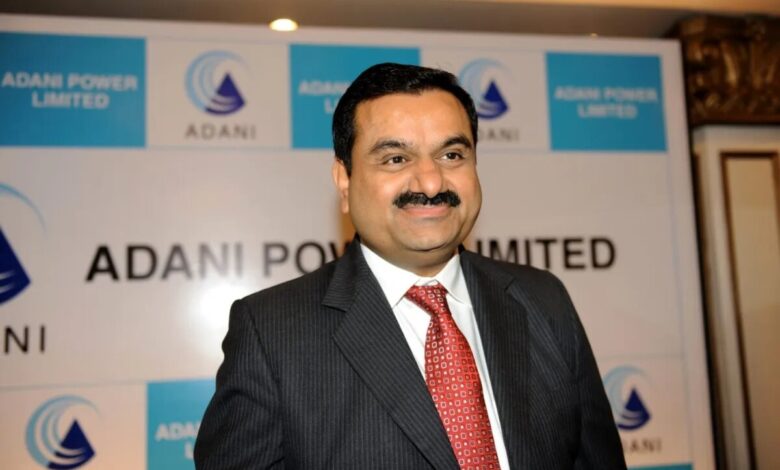
India’s Adani Group On A downfall Spree As Huge Debt Trap Drastically Raises Red Flags. Very Soon PSU Banks Themselves End Up In The Hands Of Corporate Entities!
According to Credit Suisse research, the conglomerate’s overall debt will increase by around 40000 crore rupees due to Adani Group’s most recent acquisition of Holcim Limited’s Indian assets. The acquisition agreement was primarily financed with debt will increase the Adani Group‘s total debt to about 2.6 trillion rupees.
The total debt of the Adani Group climbed from 1 trillion to 2.2 trillion rupees over the previous five years.
Most of these debts were utilized to buy assets and enterprises in industries, including extensive infrastructure, ports, airports, and green energy companies.
The conglomerate’s debt increased due to the choice to expand into the energy and electricity transmission industries.
Adani also revealed plans for an eastern India aluminum refinery for US$5.2 billion. According to Bloomberg, he spent at least US$17 billion on acquisitions in the 12 months to May.
The operations of the Adani Group have recently undergone an excessive expansion. The Group has established dominance in various industries, including ports, airports, power, coal, renewable energy, cement, aluminum, and, more recently, the 5G spectrum.
These ventures may have been driven more by loan capital than by equity, which the RBI should be concerned about it.
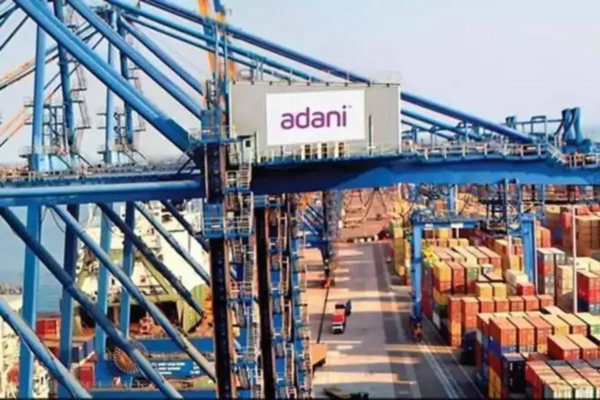
According to a report, The Adani group is mounting a massive debt of 2.2 trillion, but Adani is also the world’s 5th richest billionaire, and people are getting happy. So much debt to only one; what kind of management is this? People should see this aspect as a shocking scenario rather than be proud that Adani became the world’s richest and India surpassed the UK as the world’s 5th largest economy.
The Adani group’s total debt is 2.2 trillion, while India’s nominal GDP is 3.5 trillion. This is such a worse situation as the Adani group’s total debt is increasing on one hand, while India’s GDP is 3.5 trillion so you can think how much debt is included in the overall India GDP value and it will pose a blunder risk to our Indian economy. A company has half the reserve of the country.
The interesting thing is that while only Adani’s company has a debt of 2.6 trillion, on the other hand, the big news is that India’s total reserve is only 4.7 trillion rupees. It simply means that almost half of India’s reserve money has gone into the hands of a company in the country, which is a suspicious situation.
Now the most worrying thing is that the entire business of Adani is standing on the foundation of debt. To invest in the earlier projects and new projects, the Adani Group is on a spree to finance debt.
It is not that companies around the world do not take loans for business, but the most worrying thing in this is that the Adani Group is continuously expanding. The big problem is that the company is constantly taking loans for this, due to which the group is getting affected day by day. The burden of debt is increasing day by day.
Adani Group in a debt trap
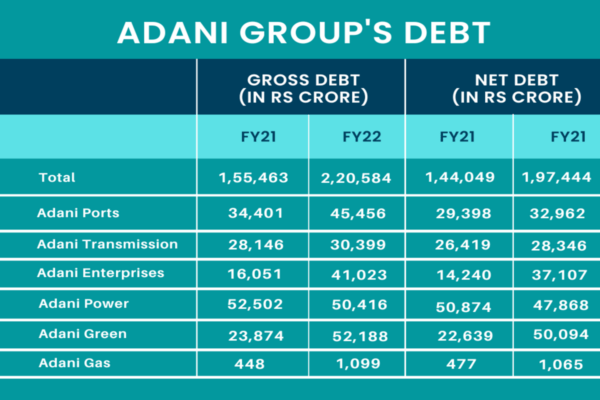
CreditSights, a Fitch Group entity, claims that Adani Group companies are significantly overleveraged because of the corporation’s aggressive use of debt for new and existing business investments.
In the worst-case scenario, according to CreditSights, Adani Group’s debt-funded growth plans might lead to a massive debt trap. It might cause one or more Adani Group firms to default or become distressed.
The Adani Group has six publicly traded businesses. These six corporations had a gross debt of Rs 2.3 lakh crore as of FY22. After taking cash into the account, net debt was still relatively high at Rs. 1.73 lakh crore.
According to the CreditSights analysis, the group’s excessive debt and overleveraging might have a negative ripple effect on the credit quality of the group’s bond-issuing firms and increase the probability of a problem spreading to other Adani Group entities.
According to the report, practically all Adani Group companies have significant development plans despite having high levels of leverage and a subpar interest coverage ratio, which is not a financially wise strategy.
Concerns about the Adani Group’s excessive debt have also been expressed by S&P. The majority of the group businesses have fairly ambitious growth goals, according to S&P Global Ratings. The group may become problematic if this is not controlled.
Why Are Banks Giving Loans?
The company has raised money effectively due to its solid partnerships with banks and respected standing in the capital markets. The team has also done admirably despite challenging circumstances.
For instance, the Australian Carmichael coal mine is now in operation despite numerous banks publicly declaring that they would not finance the project. Many individuals and groups vehemently opposed this concept.
Adani has embraced the business strategy of acquiring every enterprise imaginable.
The debt load will be a significant issue if the group can keep increasing its debt.
The entire loan sum is approved for the development of phase 1 of the copper project by a group of banks under the leadership of SBI. Bank of Baroda, Canara Bank, Exim Bank of India, Indian Bank, Punjab National Bank, and Bank of Maharashtra are the other consortium members.
Nearly 40% of the significant loans taken out by the Adani Group, totaling Rs 48,000 crore (from April 2020 to June 2022), are funded by SBI alone, or Rs 18,770 crore.
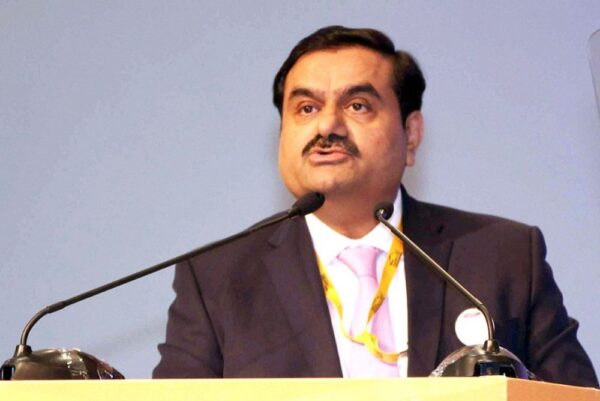
Who in the government is exerting such enormous pressure on banks like the SBI to lend money of such a vast amount, risking both the banks and the country’s economy?
In addition to being on an acquisition binge and receiving funding from banks, he also has close links to Modi.
Additionally, the SBI drafted an in-principle agreement with the Adani group for a $1 billion credit as soon as the Modi government took office in 2014 and sought the assistance of numerous international banks to raise the necessary funds.
The question comes now why is there so much of a drastic increase in the loan taken by the Adani Group? Why are the banks granting such a huge amount of loans to the Adani Group?
Is Adani Group repaying the loans they borrowed from the banks? If Yes, why does it keep on drastically increasing, and Adani Group keeps on investing in their projects?
On the one hand, It is making vast investments in its various projects; on the other hand, the Adani group is in the grim shadow of a massive debt trap. What an irony! Interestingly, the debt is raising concerns and alarming red flags, but the investments are continuously being carried on!
More concerning is the fact that large corporations are gaining control of the media, which could harm our democracy. In my opinion, the Central government should also take prompt action to protect the independent press and media.
Why are the finance ministry and Sebi remaining silent throughout the hostile takeover of a prominent TV news channel?
What is the Modi government’s strategy to prevent collateral harm and cascade effects in the event of failure or a delay in loan repayment, given the Adani group’s rising debt?
The Adani Organization and another private business, Greenko, have signed MOUs for over 20,000 MW of pumped storage projects across more than 6 States, all through highly opaque means, to give one recent example of how this group is actively foraying into new fields.
Some of the project locations were chosen in a way that results in a breach of the unique rules that apply to Scheduled Areas, like the PESA and the FRA. The amount of capital needed for this could reach Rs 1 lakh crores, most likely coming from PSU banks and other institutions like the PFC. By any stretch of the imagination, this sum is negligible!
Given that the Government of India and the general public both control PSU banks, which will be required to pay the majority of this debt, it creates significant public interest issues.
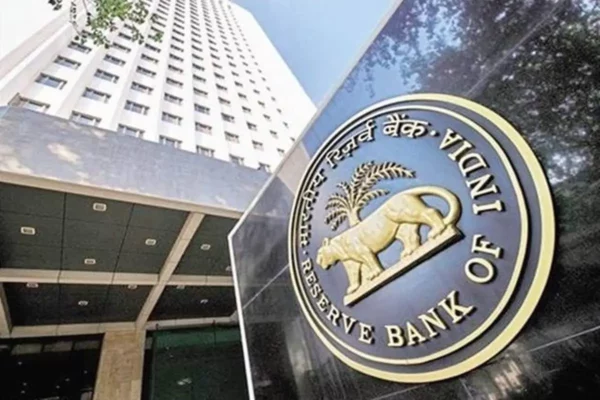
Under the Banking Regulation Act, the RBI is mandated by law to oversee how banks conduct their business to protect the interests of depositors and equity investors.
PSU banks are responsible for funding corporate houses, which benefit from the government’s massive, indiscriminate programs to disinvest CPSEs and their valuable assets. If the Ministry of Finance’s plans to privatize them come to pass, it shouldn’t come as a surprise if the PSU banks end up in the hands of corporate entities very soon!
edited and proofread by nikita sharma






